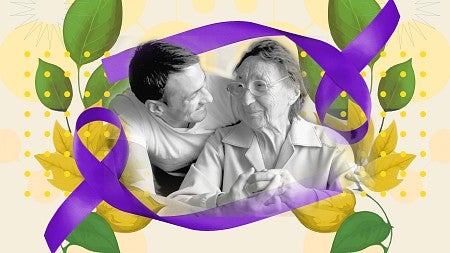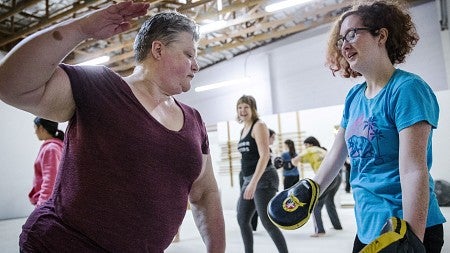
Researchers Baldwin, Measelle, Pfeifer and Caouette Examine Youth and Teen Behavior
Faculty members are gaining insights into the nurturing of a healthy mind, from newborns to teens
By Michele Taylor • January 21, 2020
8 min read
Squeak a ball in front of a baby’s face. Pop it up and catch it. Bounce it a few times and watch his eyes light up with joy. Big, round, happy eyes mean he is watching and assimilating these movements. By catching balls, playing with blocks, and banging on pots and pans, his parents and other caregivers are setting the foundation for healthy brain development.
This sort of motion—demonstrative, exaggerated, even theatrical—is essential for nurturing young minds. Another factor for brain development is the time parents spend interacting with their children. Then, as children become teens, their maturing brains are affected by interactions with peers, in person and through social media. Low self-esteem and cyberbullying can lead to mental health disorders such as anxiety and depression.
Four University of Oregon faculty members are making important inroads in our understanding of the growing brain. They’re examining critical stages for babies and adolescents and advising caregivers on how to nurture young minds for healthy development.
The Cheerios airplane nourishes learning
There is a scientific reason why parents scoop Cheerios into a spoon, pretend the spoon is an airplane, and make airplane noises as it swoops, dives, and curves before landing in the hangar, otherwise known as their baby’s mouth. Psychology professor Dare Baldwin dubbed this “motionese”—the language of motion—and found it promotes healthy brain development.
She is researching how mothers nurture their babies’ brains through motionese. The term describes how adults instinctually exaggerate hand motions when playing with their babies. It slows down a complex stream of gestures so babies can understand them, Baldwin says—when babies understand movement, they can repeat it. In the example of the Cheerios airplane, the baby learns how to feed herself; later, she will watch her parents’ exaggerated motions to learn more complicated movements, like how to tie her shoelaces.
Baldwin and her colleagues compared how moms and babies or moms and adult friends interact with toys.
When moms presented toys to their friends, they kept space between them and didn’t maintain eye contact. When moms interacted with their babies, they moved closer before introducing the toys. They played with the toys near the babies’ faces; their hand motions were slow, highly gestural, and repetitive. Moms looked at their babies with enthusiasm to make sure they were paying attention.
Baldwin found that babies’ pupils dilate precisely when one motion stops and the next one begins. When babies watched the faster, more complex sequence of hand gestures used between adults, their pupils didn’t change.
Dilation is a sign of cognitive engagement, Baldwin says. It shows that motionese focuses babies’ attention to help them grasp motor skills.
Raising crops, raising children
Because of poor nutrition and medical care, 40 percent of babies born in northern Lao villages die from diarrhea and respiratory diseases before their fifth birthday. There are no wellness centers providing day-to-day care and the drive to the nearest hospital takes hours. “The needs facing these children are immediate and in most cases can’t wait until a child reaches a hospital,” says psychology professor Jeff Measelle. “That’s too late.”
Like Baldwin, Measelle studies the importance of social engagement for healthy brain development. He’s helping parents in rural Laos care for their babies to prevent premature deaths and cognitive impairment.
From infancy through early childhood, many babies in rural Laos spend most of their time tucked into baskets or on a caregiver's back as their parents tend to vegetable patches and rice paddies. But babies benefit from lots of interactive time with their caregivers, Measelle says, to set the stage for the development that follows. Without it, children are less likely to reach their potential.
In response, Measelle founded 400 Grams—www.400Grams.org—a nonprofit organization named for the weight of a healthy newborn brain. The goal: reduce the incidence of childhood death from preventable diseases and aid kids’ cognition by working with villages to build daycare centers.
Measelle teamed up with Volun-Tour Laos, an organization that has served rural communities for 20 years, to ensure his assistance is sensitive to Lao people and culture. Measelle and Volun-Tour Laos designed a co-op system to provide daycare. Villagers dictate features they want in the centers—an adjacent garden or space for wellness check-ups—and families alternate between daycare duty and tending fields.
Children in a Laos village
“We were not just going to throw money at this problem,” Measelle says. “We wanted to get it right culturally and scientifically by working hand in hand with families and village leadership.”
400 Grams and Volun-Tour Laos have built six daycare centers and four more are in development. Parents learn prenatal and neonatal care and caregivers play with babies to stimulate their growing brains. Over time, 400 Grams will taper its role while parents increase theirs.
Evaluations of the children attending the centers reveal that most suffer significantly fewer episodes of pneumonia or nutrition-related diarrhea than kids in nearby villages without these facilities, Measelle says. They have also scored higher on cognitive and language tests than the other group and have matched the results of peers in more developed countries.
One Lao mom told Measelle the center is helping her raise her children to be educated and intelligent. “Even though I am not a teacher,” she said, “I want to ask my daughter what she wants to be when she grows up and help her with that choice.”
Avoiding the storm of social rejection
Decades ago, kids judged their popularity by the number of Valentine’s Day cards they received from classmates. Now, they count Twitter “followers,” Instagram “likes,” SnapChat “streaks,” and TikTok “duets.”
Unfortunately, one consequence of the connectedness provided by social media is the risk a user will suffer a powerful, amplified wave of rejection from peers. That sense of rejection can damage a young mind.
This constant evaluation, particularly when it’s adverse, may explain why today’s youth suffer from high rates of depression and anxiety, says Justin Caouette, associate director of the Prevention Science Program in the College of Education. Social media mania hits precisely when young brains are at maximum vulnerability to social stress, he adds—“it’s a perfect mental health storm.”
Caouette, previously a postdoctoral researcher and instructor with the Department of Psychiatry at Oregon Health & Science University, has studied the relationship between peer rejection and adolescent-onset anxiety and depression.
Working with collaborators at University of California, Davis, he found that when a teen is rejected on social media, there is a profound, negative impact on brain development. This manifests as kids “shutting down,” he says, which is a gateway to anxiety and depression.
Using an MRI machine to measure how teens’ brains processed rejection, the team observed in real time how chronic exposure to rejection dulled and desensitized the frontal cortices—the part of the brain responsible for emotional regulation, problem solving, and decision making.
Caouette’s expertise in social factors contributing to adolescent mental and behavioral health is complemented by the work of more than a dozen researchers in the prevention program. They’re making advances in areas including partner violence, alcohol and drug use among college students and young adults, unhealthy eating, issues facing Latinx adolescents, and more.
For his part, Caouette believes schools can do more to help teens get on track and keep them there. For example, he advocates for “brain education” classes—similar to sex education classes—so that teens and their families can begin to grapple with the complex social factors that influence the developing mind.
Says Caouette: “We can take what we learn about the growing brain and emotional health and change policies in schools to improve outcomes.”
Addressing mental health among teen girls
When adults recall puberty, they often remember it as an awkward phase. Many changes happen all at once in adolescents’ bodies, brains, and relationships. Also, teenagers vary in when and how fast they go through these changes—and that can affect their well-being, says Professor Jennifer Pfeifer, of the psychology department.
In a project funded by the National Institute of Mental Health, Pfeifer is examining physical, neural, and social development in teenage girls. By age 18, about one in five girls will suffer from mood or anxiety disorders and other mental health issues. These mood and anxiety disorders are about twice as common in adolescent girls as boys—and girls who go through puberty earlier or faster than their peers are at even greater risk for problems.
Therapy, Pfeifer says, can improve mental health and help the adolescent brain onto a better course. Even better, if scientists can identify predictors for mental illness, strategies can be introduced to prevent adolescents from developing a disorder.
Pfeifer is following almost 200 girls recruited from elementary and middle schools in the Eugene-Springfield area. These girls were 10 to 13 years old at the start of the study; every 18 months, UO researchers in the Developmental Social Neuroscience Laboratory record their brain development, physical growth, and hormone levels. The girls complete a mental health interview and questionnaires about social relationships and how they see themselves. From this information Pfeifer gains an understanding of where the girls are in adolescent development and whether they are experiencing symptoms such as depression or anxiety.
Pfeifer uses neuroimaging to study development of brain structure, activity, and connectivity between regions. Among other things, she studies how the adolescent brain processes information about the self: while lying in an MRI machine, girls read positive and negative personality traits—such as “caring” or “bossy”—and report which ones describe them. Pfeifer simultaneously measures responses in different parts of the brain and compares this information to the girls’ pubertal development, social status, and mental health, for example.
Teenagers—and girls in particular—need close friendships to protect against depression, anxiety, and peer rejection. However, sometimes girls get together and ruminate about problems, which can instead increase their risk for depression. So Pfeifer also examines brain activity while girls decide what to share about themselves with a close friend, and whether these decisions relate to their mental health.
There are very few studies of this nature, Pfeifer says, given the many waves of data collected across multiple levels of study—hormones, brain development, social relationships, self-perceptions, mental health—that continue to change during puberty.
A deeper understanding of the social and neural processes linking puberty and mental health will identify critical ways for programs to better prevent and treat mood and anxiety disorders in adolescent girls, she says.
Michele Taylor, MS ’03 (journalism: magazine), BA ’10 (French) is a freelance writer in Eugene.




